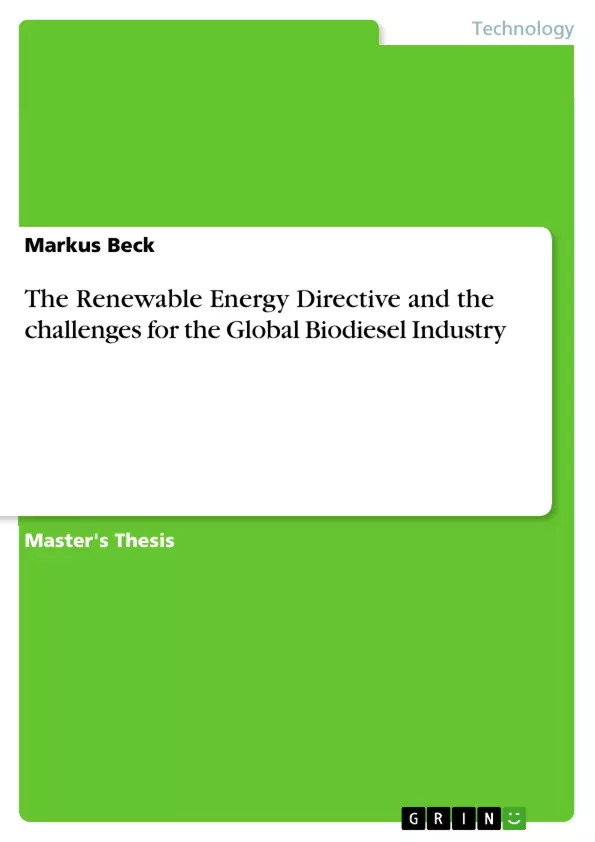In response to climate change and unsustainable energy consumption, the European Parliament launched a climate and energy package in 2009. This included the 20:20:20 Energy Strategy aimed at decreasing the effects of climate change, in particular by lowering greenhouse gas (GHG) emissions by 2020. This 10-year action plan proposes measures to increase the current efficiency levels of energy use and raises the share of renewable energies within the energy mix for all 27 EU Member States. As a result the increased use of biofuels, particularly in the transport sector, will be an important part of a more complex framework. Although biofuels represent only two per cent of total transport fuels used, political incentives, technology and efficiency improvements could increase this by eight per cent in Europe by 2020.
In line with the 20:20:20 Strategy, the Renewable Energy Directive (RED) was introduced to regulate the overall biofuel market, amongst others. Based on the RED’s definition of sustainability, different certification schemes emerged, aimed at creating a uniform biofuel standard within Europe. At present, the overall scale and scope of environmental and social impacts associated with the biofuel supply chain are not well defined and this will be evaluated within this thesis. Furthermore, close ties between the biofuel supply chain and other sectors including food and crude oil industries lead to associations with issues such as deforestation, pollution and food supply shortages. Thus, this thesis will analyse whether RED actually supports such a low-carbon pathway or it mainly supports the local industry. As such, the RED has been critically regarded as a market protectionist mechanism for the European agricultural and biofuel industry against the comparatively more competitive biodiesel imports from Argentina and Indonesia. Finally, the EU set a tone with its Directive, encouraging international collaborations with other governments to work towards sustainable energy measures as part of a universal climate change solution.
Inhaltsverzeichnis (Table of Contents)
- Introduction
- Motivation and research objective
- Methodological approach
- Structure of the thesis
- The Renewable Energy Directive (RED)
- Background on the RED 2003/30/EC on commodity and biofuel trade
- The Renewable Energy Directives 2009/28/EC and 2009/30/EC
- The biofuel industry
- An overview of the biofuel industry and its players
- The biodiesel value chain and different types of feedstock
- Feedstock production, crushing plant and oil production
- Biofuel production and chemical background of transesterification
- Trade flows and concrete example of a Supply Chain Manager
- GHG emissions as main sustainability criteria for biodiesel
- Criticism on criteria regarding GHG emissions and biodiversity
- Crop rotation and Genetically Modified Organism
- Direct (DLUC) and indirect land use change (ILUC)
- Political frameworks and incentives for the biofuel industry
- Argentinian's export tax driven biodiesel industry
- Splash and Dash - a US case study on import and tariffs
- Sustainability certificates and voluntary schemes - 2BSvs case study
- Criticism on sustainability schemes
- An outlook into second and third generation biofuels
- Price increases and price volatility cause food shortage and hunger
Zielsetzung und Themenschwerpunkte (Objectives and Key Themes)
This thesis explores the impact of the European Union’s Renewable Energy Directive (RED) on the global biodiesel industry. The main objective is to analyze the challenges and opportunities for the global biodiesel industry within the framework of the RED.- The impact of the RED on sustainability and environmental concerns associated with biodiesel production
- The role of political frameworks and incentives in shaping the biofuel industry, particularly focusing on export taxes, tariffs, and sustainability certification schemes
- The complexities of the biodiesel value chain, including feedstock production, processing, trade flows, and GHG emissions
- The potential conflicts between biodiesel production and other sectors, such as agriculture and food security
- The future prospects for the biofuel industry, including the development of second and third-generation biofuels.
Zusammenfassung der Kapitel (Chapter Summaries)
The thesis begins with an introduction outlining the motivation for the research, the methodological approach employed, and the overall structure of the work. Chapter 2 dives into the history and development of the Renewable Energy Directive (RED), examining the initial 2003/30/EC directive and its later revisions in 2009/28/EC and 2009/30/EC. Chapter 3 provides a comprehensive overview of the biofuel industry, its key players, and the complexities of the biodiesel value chain. It examines various stages of production, including feedstock production, oil extraction, transesterification, and trade flows. The chapter also analyzes the significance of GHG emissions as a sustainability criterion for biodiesel production. Chapter 4 explores the political frameworks and incentives that influence the global biofuel industry, including case studies from Argentina and the United States. It examines the role of export taxes, tariffs, and sustainability certification schemes. The thesis concludes by evaluating the RED’s effectiveness in supporting a sustainable biofuel industry and discusses the potential for second and third-generation biofuels.Schlüsselwörter (Keywords)
The key themes and concepts explored in this thesis include: Renewable Energy Directive (RED), biodiesel, biofuel, sustainability, GHG emissions, land use change (LUC), political frameworks, incentives, export taxes, tariffs, sustainability certification schemes, value chain, feedstock, transesterification, trade flows, food security.- Arbeit zitieren
- Markus Beck (Autor:in), 2012, The Renewable Energy Directive and the challenges for the Global Biodiesel Industry, München, GRIN Verlag, https://www.grin.com/document/200633



